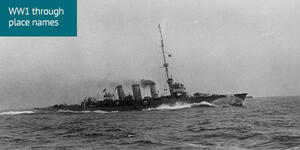
British cruiser HMS ARETHUSA at speed, 1914.
In 1924, Sir Frederick Chapman, a former Supreme Court judge and member of the Honorary Geographic Board of New Zealand, suggested new names for two features on Lake Wanaka. He proposed that the body of water on ‘Pigeon Island’ should become Arethusa Pool and that the Island’s highest point should be titled Tyrwhitt Peak. When the time came to seek official approval for these changes, the Governor-General, Admiral John Jellicoe, further moved that ‘Pigeon Island’ be renamed ‘Harwich Island’.
Chapman’s submission of Arethusa Pool was based on two considerations. Firstly, he noted that the feature was not stream-fed, but rather obtained water from snow that melted off the surrounding mountains and then travelled through rock fissures. To Chapman, this phenomenon recalled the site in Syracuse known to the Ancient Greeks as ‘Arethusa Spring’.
The second factor concerned the light cruiser HMS ARETHUSA, which had served as the flagship of the Royal Navy’s Harwich Force under Commodore Reginald Tyrwhitt. Formed at the outbreak of the First World War, this squadron was given three main objectives: to protect the approaches to the English Channel; to monitor German activities in the North Sea; and to escort ships sailing between Britain and the Netherlands.
The ARETHUSA’s wartime service proved extremely eventful. She was so badly damaged at the 1914 Battle of Heligoland Blight that she had to be towed back to port. Having been refitted, the ship then took part in the Cuxhaven Raid and the Battle of Dogger Bank, before capturing four German trawlers in September 1915. On 11 February 1916, the ARETHUSA struck a mine off the coast of Felixstowe and sank with the loss of six of her crew.
The name Arethusa Pool was first Gazetted by the Honorary Geographic Board of New Zealand in 1924, and was officially confirmed by the New Zealand Geographic Board in 1948.
References:
- Colledge J.J. and Barlow, Ben, Ships of the Royal Navy: The Complete Record of All Fighting Ships of the Royal Navy from the 15th Century to the Present, Newbury: Casemate, 2010.
- Evening Post, 14 November 1924, p. 2.
- Honorary Geographic Board of New Zealand: Correspondence, vol. 11, pp. 166-170.
- New Zealand Geographic Board: Correspondence, vol. 42, p. 156.
- New Zealand Geographic Board, ‘New Zealand Gazetteer’